
A recession is a period of reduction in economic activity. In a recession, unemployment will rise and output will fall. A depression is a more severe and a longer lasting recession.
Written as a commonly quoted joke:
This is a graph of change in Unemployment Rate with change in Circulating Money superimposed. Circulating Money is that portion of the Money Supply that changes hands within one month. The graph shows the importance of maintaining a steady level of Circulating Money. A 5%fall in Circulating Money can cause 30% or more rise in unemployment. A rise of 5% in Circulating Money can cause a similar fall in unemployment. I will demonstrate, through the chapter that we need to monitor Circulating Money rather than Money Supply to handle recessions.

This graph shows Circulating Money and Government Tax Revenue. Tax revenue falls drastically when Circulating Money falls. The situation is even more dramatic for Income Tax and more dramatic again for Corporate Income Tax.

Some recessions can be attributed to asset bubbles. This is the over valuation of a particular class of assets. This overvaluation can be attributed to enthusiastic bank lending for the particular asset class. This lending enthusiasm wanes as the assets become overvalued and the availability of credit is subsequently withdrawn. The banks stop lending whilst continuing to collect repayments and interest.
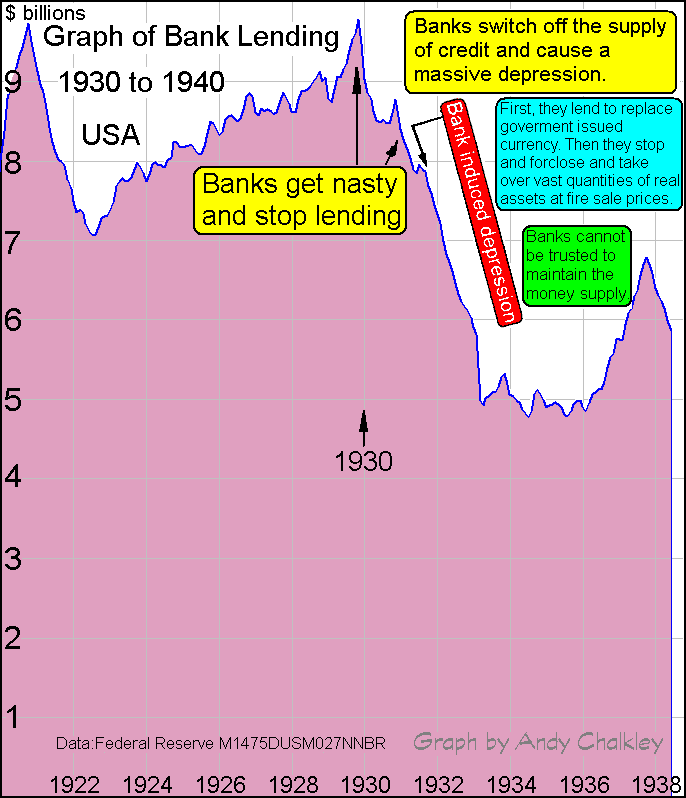
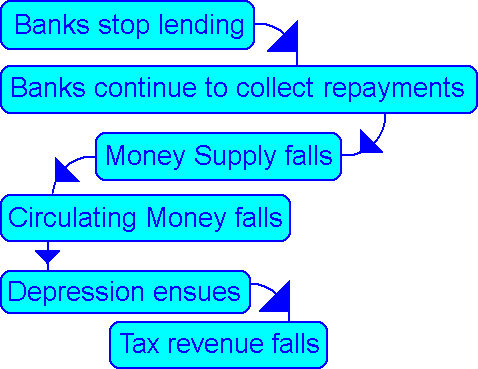
This leads to a reduction in the Money Supply which invariably leads to a fall in Circulating Money which is felt as a recession.

During a depression, there appears to be a reduced demand for services and products. However, it is not that the citizens no longer desire the services and goods, but that they do not have the means to purchase these items. Although an economist may say that demand has reduced, the human desire remains. The lack of demand is caused by a lack of available income or a reluctance to spend the income. The economy retreats. It is likely that the citizens desire work that they cannot obtain and it is likely that there is plenty of work to be done. So the citizens would buy if they could get their hands on money and the factories would hire if they could sell and the factories could sell if they could find citizens with money. So it is a catch-22 situation. Citizens would buy if they could get jobs and the factories would employ if they could sell. What is the missing ingredient? The answer is the transport medium to facilitate the two transactions. Even factory issued IOUs would work. There is no shortage of work to be done and there is no shortage of willing workers and there is no shortage of materials or supplies, but citizens are sitting idle because the simple transaction train: ‘employee earns wages’ – ‘employee spends wages’ is stifled for a lack of transaction tokens in the local society. The result is starvation.
During a depression, there are unemployed people wishing to work to earn money to buy items. They still have the enthusiasm to buy things but do not have the money. Demand exists but cannot be realised. Factories have idle capacity and desire to sell. They have capable applicants in waiting. The economy has latent demand and latent production potential. Yet demand remains unfulfilled, potential employees remain idle and production equipment remains stationary.
I give you some excerpts from an 1888 book by Mrs. Sarah E.V. Emery to give the flavour of a recession and add some gravity to this economic event. I assume Sarah was talking about ‘The Long Depression’ which was the depression that ran from 1873 to 1879. It was kicked off by the Panic of 1873. Firstly, I give you the words of an economist, then I give you the words of an impoverished citizen. This is to emphasise that we should consider these recessions as ‘human disasters’ and not ‘academic economic novelties’.
In the years before 1873, there had been excessive speculative investment in railroads. There was a speculative boom in railroads followed by a bust. Even the banks, themselves had been speculating. The banking firm of Jay Cooke and Company had been heavily investing in railroad construction. It closed its doors in September 1873 and a major economic panic swept the nation. The New York Stock Exchange ceased trading for ten days. Unemployment rose to 14%. [5] In the US, between 1873 and 1879, 18,000 businesses went bankrupt, including 89 railroads. [7] Ten states and hundreds of banks went bankrupt. [6] The Panic of 1873 was the start of a global financial crisis which led to a severe depression in Europe and the United States. It is a good argument for restricting banks from investing for their own profit and only allowed to invest their for their clients.
Adapted excerpts from the 1888 book:
by
“Wherever we turn is discontent; labor idle, or at least working on short time and low pay; mill after mill silent; furnaces cold and unproductive; tramps filling our highways; the gaunt wolf of starvation staring into desolate homes, and strikes against starvation wages those forerunners of revolution springing up on every hand. On the other side, we see granaries bursting with the abundance with which God has fattened the land, palatial mansions rising in fabulous magnificence, and mountains of wealth the product of half-requited labor poured into the coffers of the idle and affluent. All over the land the wail of distress comes up from poverty-stricken homes crushing out the manhood and womanhood of human kind, blighting the beauty and buoyancy of youth, and destroying the faith of mankind in an all-wise merciful father. In a land of plenty, where the willing hand of industry has created untold wealth, why should that hand be paralyzed for want of the very wealth it has created ? Why should comfortable food, clothing and homes be denied to those who have produced these things in such abundance?
There is no doubt but that the unequal distribution of the products of labor is one of the most fruitful sources of social and political disturbances.
Any rational person must admit that a nation’s prosperity does not lie so much in the amount of its wealth as in a just distribution of that wealth among those who have produced it.
That nation is the most prosperous whose laborers hold warranty deeds, rather than leases of their homes, and a hundred cottage homes and gardens owned by a hundred workingmen is greater evidence of national prosperity than a million of property in the hands of a single individual. The ownership of home is the great safeguard of liberty, and it is impossible for a people long to remain free who do not own their homes. History bears us out in this statement, and we trace with minuteness the connection between land monopoly and national death. God has implanted in the human heart an unquenchable thirst for knowledge and for liberty, a knowledge of that liberty which makes men free from the bondage of their physical necessities and breaks the manacles of that slavery which through all ages, the strong have imposed upon the weaker portion of mankind.
The civilized brigandage of today is ashamed of its ancestry, but its appetite for plunder is no less ravenous and daring. Modern brigandage is carried on under more euphonious titles, and new methods of robbery are employed. Instead of “robber king” and “brigand chief” we have today the money king, the coal king, the cattle king, the railroad magnate, the telegraph monopolist and the lumber baron. Instead of spoils and plunders, we have interests, dividends, revenues and rents.”
The seriousness of a recession should never be underrated as the level of human suffering and misery is not to be ignored. This is not just the idle bantering of economists but the lives and happiness of millions. Depressions are treated as an economic issue. However they should also be treated as a human tragedy.
This is an inappropriate name for a terrible event. It is like calling the First World War the ‘Great War’. The Dreadful Depression would be more appropriate. This graph of GDP during the Great Depression shows a dramatic fall followed by a second fall:

This next graph shows Unemployment during the Great Depression:

If we look at the graph of Money Supply below, it is easy to come to a conclusion that the depression was caused by a fall in the Money Supply. Please notice that there was no fall in the government-issued Cash Currency.
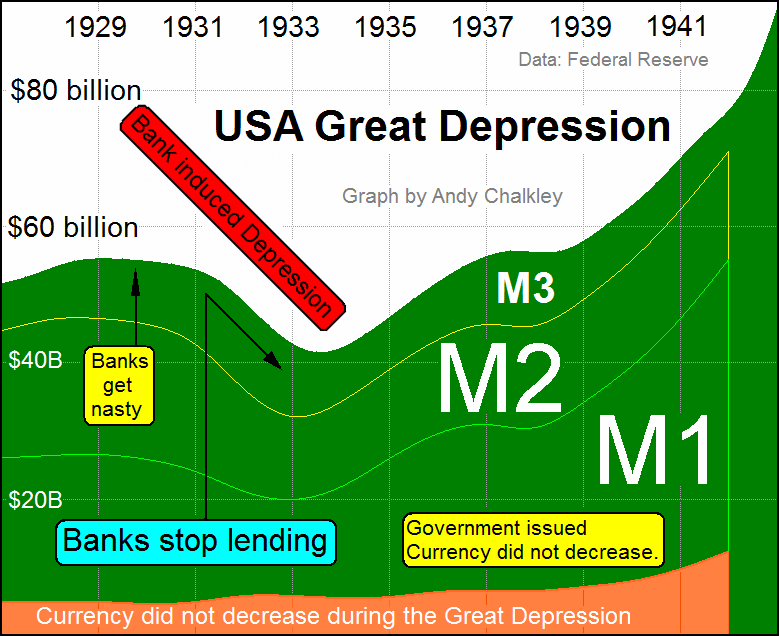
Cash Currency did not fall. It was bank credit that fell. What determines the volume of bank credit? Bank credit is created when banks extend loans. Bank credit increases when citizens borrow money and bank credit reduces when people pay off loans. If banks issue more loans than they collect in repayments, the Money Supply increases. If the banks collect more repayments than they issue new loans, the Money Supply falls. It follows that if the banks are shy about issuing loans, the Money Supply falls. If the citizens are reluctant to take on more debt, the Money Supply falls. It may be masked by comments such as: “a freeze on credit” or other covering terms such as: “credit squeeze”. The citizens might resist the temptation to take on loans if they are ‘maxed out’ on debt. This might occur when a high proportion of their income is already being spent on tax and interest. In the above graph, you can see that the government issued Cash Currency did not fall. You can see that M1 and M3 fell spectacularly.
There is an error in the commonly espoused logic that recessions are caused by a fall in the Money Supply. It assumes that the velocity remains constant.

This same effect can be caused by a decrease in velocity as might occur if excessive money became hoarded. It leads to the erroneous assumption that to correct a recession/depression, all that is needed is to raise the Money Supply. This is an erroneous and costly error. A recession is characterised by a falling GDP. But velocity, Money Supply, and GDP are related as in the following formula:
Money Supply x Velocity = GDP
Thus, a fall in the Money Supply OR a fall in velocity will cause a fall in GDP. Thus, we get the ridiculous statement that a fall in GDP is caused by a fall in GDP.
Let us look at some more graphs. The first is the relative percentages of Circulating Money and Hoarded Money. There is a fall in the percentage of Circulating Money which erroneously suggests that Hoarded Money has increased.
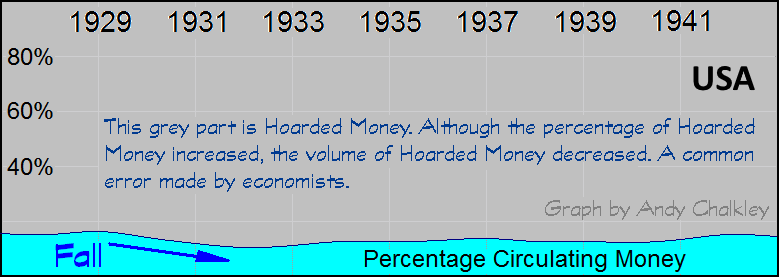



The fall in GDP is influenced by falls in velocity or Money Supply or both. Let us consider the money that is used by business and customers. To get a better understanding, I calculate the volume of Circulating Money. I consider Circulating Money to be money that is moving from citizen to business to citizen to business constantly. I have chosen a time of one month for convenience. For many people, their wage has gone within a week, many shops purchase stock daily or weekly. Many businesses would turn their money over within a month. I use an arbitrary cut off of one month. Money that transacts in less than one month is considered to be Circulating Money and money that is held for more than one month is considered to be Hoarded Money. I was doing some tedious calculations on spreadsheets to obtain values for Circulating Money until I spotted that Circulating Money turns out to be GDP divided by 12. Although this seems odd, it allows us to better conceptualise the movement of money and the actions that might damage the economy.

Circulating Money is the money that is changing hands between customers and businesses and suppliers. It is the money moving in the real economy. During the Great Depression from 1929 to 1933: [10]
| M3 | fell by | 25% |
| M2 | fell by | 31% |
| M1 | fell by | 25% |
| GDP | fell by | 46% |
| Circulating Money | fell by | 46% |
| Hoarded Money | fell by | 21% |
| Velocity | fell by | 29% |
| Currency | ROSE by | 20% |
| Unemployment | ROSE by | 688% |
| National Debt | ROSE by | 17% |
| Federal Total Tax Revenue | fell by | 48% |
Please note: Cash Currency did not fall. It rose by 20%. This was not a government created phenomenon. Also notice that a 25% fall in the Money Supply caused a 46% fall in Circulating Money which caused a 46% fall in GDP which caused a 688% fall in unemployment.
The Money Supply M3 fell by $13.7billion, Circulating Money fell by $4billion. GDP fell by $47billion. Federal taxation fell by $1.9billion. State taxation also fell by possibly another billion. Circulating Money is the portion of the Money Supply that does the heavy lifting. A fall of Circulating Money of $4billion of money that is created at no cost to the creator and lasts for years caused devastation for the nation.
In the recovery stages from say 1934 to 1942:
| M3 | increase by | 87% |
| M2 | increase by | 107% |
| M1 | increase by | 153% |
| GDP | rose by | 148% |
| Circulating Money | increase by | 148% |
| Hoarded Money | increase by | 78% |
| Currency | increase by | 130% |
| Unemployment | decreased by | 98% |
| Velocity | rose by | 27% |
| National Debt | rose by | 168% |
| Federal Total Tax Revenue | rose by | 395% |
Here is something you must note. Most of the increase in the Money Supply became hoarded. In the recovery stage, an increase in the Money Supply of $38 billion caused a Circulating Money increase of $8 billion, while Hoarded Money increased by $30 billion. This was accomplished whilst the National Debt increased by $45 billion. A National Debt increase of $45 billion caused a Circulating Money increase of $8 billion. Most of the money became hoarded. The usual economic analysis tends to make one think that hoarding decreased because the velocity rose by 27%. This is misleading and incorrect.
In the recovery stage, an increase in Circulating Money of $8billion (created at no cost) caused a GDP increase of $99billion and an increase in Federal Tax Revenue of $11.7billion.

Hoarded Money remains stagnant and adds nothing to the level of the real economy. People who have ‘more money than they can spend’ tend to put money in the bank and leave it there for years. Hoarded Money includes savings by citizens and organizations as well as money put into tax havens denominated in national currency. Hoarded Money is generally held by those with ‘more money than they can spend’. Circulating Money passes between people quickly and tends to be with people that spend quickly and are thus more likely to have little in reserve.
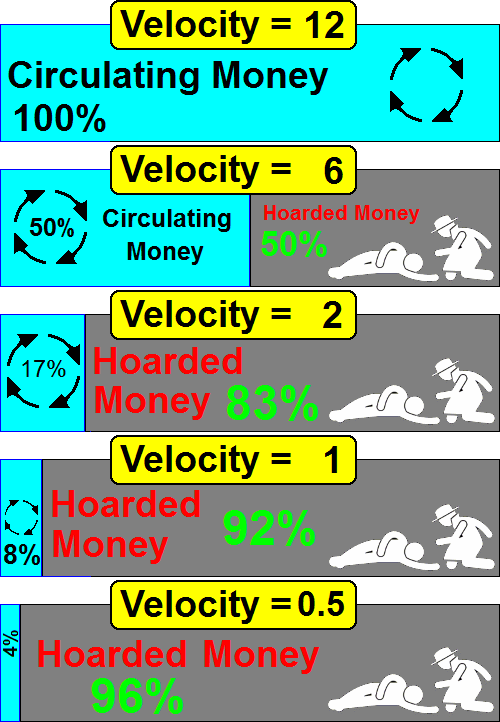
Most taxes are taken in the form of Sales Tax or Income Tax. Both of these taxes involve removing money at the time of a transaction. Thus, these two taxes are removed from Circulating Money. Most taxes are removed from the vital Circulating Money. It is easier to remove tax at the time of a transaction as the buyers are less aware of slight increase in price at the time of a purchase. They have factored the tax into the price of the purchase and do not begrudge the tax. Hoarded Money is almost completely untouched by any tax.
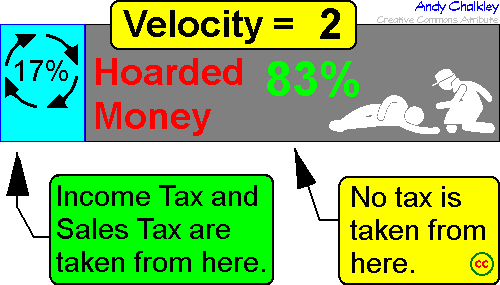
Interest comes from those that borrow, not those that have ‘more money than they can spend’. Thus, interest repayments are taken from Circulating Money.
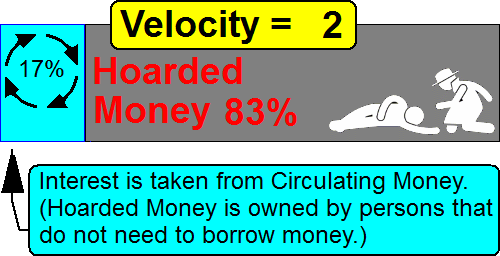
Circulating Money moves from customers to business to supplier to citizen-wages and variations of this loop. As soon as Circulating Money gets into the possession of someone who has ‘more money than they can spend’, it becomes Hoarded Money. It is easier for money to move from Circulating Money to Hoarded Money than the opposite. Hoarders are remarkably skillful at increasing their hoards. Citizens with no hoardings tend to bouncing from wage packet to wage packet in order to keep their families fed and pay interest to the bank.

When money is removed from the Money Supply, it is almost always taken from Circulating Money. Circulating Money is moving from citizen to citizen on a daily basis. It is remarkably easy to ‘skim’ a little from this transient money. Bank interest, bank repayments and almost all tax is all taken from Circulating Money. The effect it to remove money that is functioning as money and leave Hoarded Money in hibernation. This has the habit of changing the balance between Circulating Money and Hoarded Money.
There is a tendency for the velocity to decrease when the Money Supply decreases. The reason is that the reduction in the Money Supply is taken from those that ‘make good use of it’ whilst the hoarders keep their hoards. When tax is increased, it comes from Circulating Money. When interest rates go up, even more money is taken from Circulating Money.


When the private banks cut back on lending, they continue to collect repayments from Circulating Money.

The result is that the Circulating Money is reduced.

Economics books tend to mention that the Money Supply is reduced, but there is a little more drama to it than that. In the following diagram, a fall in the Money Supply of 8% has the potential to reduce the Circulating Money by 50%. This has the potential to reduce the GDP in a similar ratio.

In the previous graph titled ‘Currency and Money Supply During the U.S. Great Depression’, the volume of government-issued Cash Currency did not falter or fall. The bank credit component of the Money Supply fell precipitously. The graphs of Greece GDP and Money Supply show similar trends. Central Bank created Cash Currency did not fall.
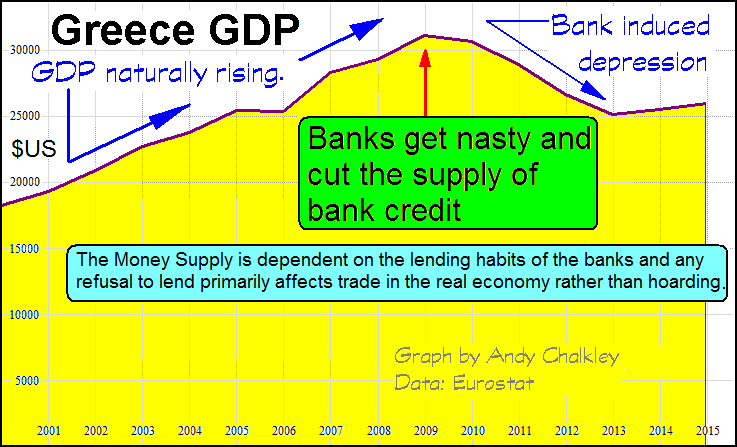
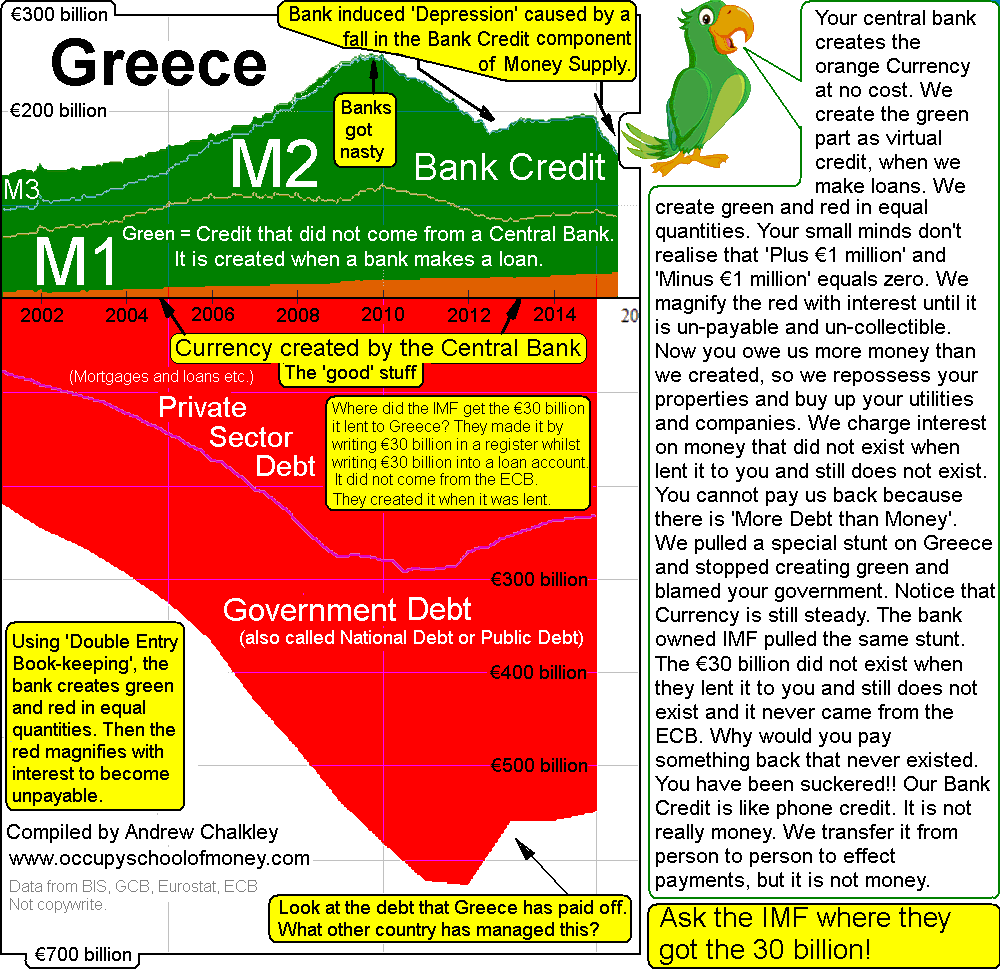

The bank credit is vastly greater than the volume of government-issued Cash Currency. Bank credit is created when banks make loans. When a bank makes a loan of a million dollars for a housing loan, it writes one million dollars with a plus sign in the seller’s account and one million dollars with a minus sign in the buyer’s account. At that instant, there is one million dollars more bank credit in the nation, the Money Supply increases by one million dollars and there is one million dollars more debt in the nation. The debt increases with interest to become unpayable. In this chapter, we are interested in the Money Supply and, by simple deductive reasoning, the Money Supply will increase when loans are issued and decrease when loans are repaid. To keep the Money Supply constant, it is necessary that loans are issued at the same rate as loans are repaid. However, interest has been added to the debt and so slightly more loans have to be issued than repayments. Thus, the constant need to increase the debts to keep the system running.
In the graph, the volume of money decreases. M1 is particularly bad and M1 is the so-called ‘Demand Deposits’ of businesses and individuals. This occurs because the banks issue very few loans whilst continuing to collect repayments. This may occur because the citizens are reluctant to take on more debt, or the banks refuse to lend. Loan repayments are taken from those that ‘do not have enough money’ and so the repayments are made from Circulating Money. Thus a reduction in Money Supply hits businesses very quickly.
When the citizens are reluctant to take on more debt or the banks cut back on the issuance of loans, the Money Supply will fall and a recession or depression will occur. If the Money Supply remains constant, a recession is a typical result. If the Money Supply falls, a depression is the typical result. Spain shows a recession. Notice that the estimated Cash Currency did not fall. Notice the lending habits of banks reflected in the balance between private debt and government debt.

Governments then make a common mistake. If the Money Supply falls, a recession/depression occurs as businesses lack trading money and capital for expansion and citizens reduce their spending. However, the reverse is not the case. If the Money Supply is increased, this does not automatically cause an increase in business activity. During a recession or depression, businesses have closed or cut back on staff and activity. It takes a lot more effort to increase production than throwing money into the Money Supply. It takes time for business owners to regain confidence and new entrepreneurs to acquire the skills to build business. It takes time for the citizens to trust the economy enough to spend at a higher level. To increase business activity, it is necessary to improve the parameters that make business worthwhile. Punitive taxes on business and expanding business is a major disincentive to expansion. Our tax system is particularly harsh on expanding businesses and comparatively kind to lacklustre and downsizing business as I shall explain elsewhere. Pushing money into the Money Supply is more likely to increase the Hoarded Money as the hoarders are skilled at getting money and hoarding. Witness a fall in velocity when a government tries to increase the Money Supply.
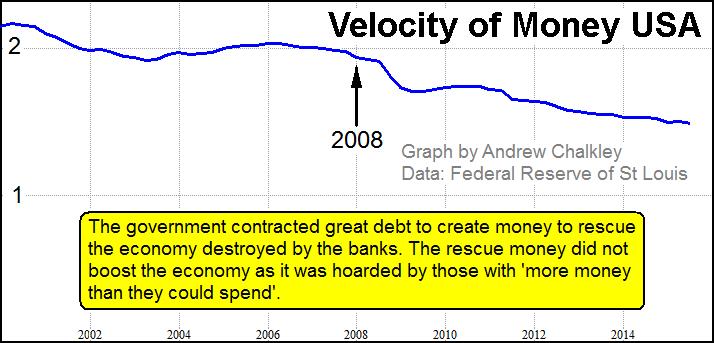
During a recession, businesses and citizens have their fingers burnt and will be reluctant to increase business activity. It is easy to assume that it is the Money Supply that needs to be increased. This is poor logic. It is the Circulating Money that needs an increase in a difficult system where the hoarders will be around to grab any money available to add to their hoards. It is not pure greed, it is that the hoarders have little need to spend and they believe that they need to hoard to have a secure future. (Little do they realise that their hoards have no value, as I shall explain in a while.) An increase in velocity will also boost Circulating Money which equates to moving Hoarded Money to Circulating Money.

This little graph shows a global problem where a greater proportion of global money is being hoarded:

The Great Depression brought extremely hard times to the people of Australia. At this time, Australia had adequate industries. There was plenty of viable farms. There were capable people willing to work. Transport was adequate. The nation had not been damaged by war. There had been no natural disasters or drought. Far from being great, the depression was a time of misery and hardship. Unemployment was high. Work was difficult to find. Businesses could not find customers. Unemployment in Australia climbed to twenty-one percent by the middle of 1930. It eventually peaked at thirty-two percent in 1932.
There were some essential ingredients for an economy to function. There was a willing workforce. There were underperforming factories and farms. There was plenty of work to be done. The missing ingredient was Circulating Money. It is only when money is available and is moving from person to person that an economy can function. Industry and commerce lacked a sufficient supply of money. Money costs nothing to create, yet it was in short supply.
Banks had cut back on loans. Banks were the source of the credit vital to the economy. The banks were refusing loans to industry, commerce and agriculture. Banks still collected interest and repayments on outstanding loans. This caused to a significant decrease in volume of money in circulation.
Due to a lack of money, people could not buy the goods and services created by businesses and businesses could not employ because they could not sell their products and services. The banks finished up with significant volumes properties and assets in their portfolios. Unfortunately the citizens are not wise to the situation and believe statements such as: “times are hard”, “money is short” as their properties fall into the hands of the money lenders. Banks can do surprisingly well out of recessions and depressions.
The depression becomes self-sustaining. Money is in short supply. Money transactions slow down. Employment falls and the payment of wages is disrupted. The purchasing power of these employees falls. There is a downfall in spending on food, goods and services. The drop in spending reduces business income causing more layoffs, factory closures and bankruptcies. It becomes difficult to increase the volume of credit because businesses are not willing to take on loans. Citizens are reluctant to take on loans for fear of retrenchment. Under a system that relies on credit from banks to maintain a Money Supply, it becomes terribly difficult to revitalise an economy. Besides the lack of credit acting as money, many businesses have had their fingers burnt or ceased trading. These wary businesses are reluctant to increase production and potential new entrepreneurs are slow to become active. Many businesses closed causing a permanent loss of the acquired skills. New entrepreneurs will take time to build-up the same level of skill in their respective industries.
In a depression, the government comes under increased pressure as the volume of persons on welfare increases whilst the tax revenue falls. Most tax revenue is taken from Circulating Money and is based on profit or volume of transactions. Taxes such as Land Tax tend to avoid this cyclical fall.
Sir Ralph Hawtrey, Assistant Secretary to the Treasury 1933: “Further, I agree with him (C. H. Douglas) that banks create money, and that trade depression arises from faults in the banking system in the discharge of that vital function.” [1]
Senator John A. Logan 1874: in a great speech, discussing the panic of 1873, said: “But, sir, that the panic was not due to the character of the currency is proved by the history of the panic itself. * * * No, sir, the panic was not attributable to the character of the currency, but to a money famine, and to nothing else. In the very midst of the panic we saw the leading bankers and business men of New York pressing and urging the President and the Secretary of the Treasury to let loose twenty or twenty-five millions more of the same paper for their relief.” [2]
On the subject of the panic of 1873 to 1877, the United States Monetary Commission says: “The true and only cause of the stagnation in industry and commerce, now everywhere felt, is the fact everywhere existing of falling prices, caused by a shrinking volume of money. * * * * This is the great cause. All others are collateral, cumulative or really the effects of that primal cause.” [2]

Andrew Jackson 1837: “The paper system being founded on public confidence and having of itself no intrinsic value, it is liable to great and sudden fluctuations, thereby rendering property insecure and the wages of labor unsteady and uncertain. The corporations which create the paper money can not be relied upon to keep the circulating medium uniform in amount. In times of prosperity, when confidence is high, they are tempted by the prospect of gain or by the influence of those who hope to profit by it to extend their issues of paper beyond the bounds of discretion and the reasonable demands of business; and when these issues have been pushed on from day to day, until public confidence is at length shaken, then a reaction takes place, and they immediately withdraw the credits they have given, suddenly curtail their issues, and produce an unexpected and ruinous contraction of the circulating medium, which is felt by the whole community. The banks by this means save themselves, and the mischievous consequences of their imprudence or cupidity are visited upon the public. Nor does the evil stop here. These ebbs and flows in the currency and these indiscreet extensions of credit naturally engender a spirit of speculation injurious to the habits and character of the people. We have already seen its effects in the wild spirit of speculation in the public lands and various kinds of stock which within the last year or two seized upon such a multitude of our citizens and threatened to pervade all classes of society and to withdraw their attention from the sober pursuits of honest industry. It is not by encouraging this spirit that we shall best preserve public virtue and promote the true interests of our country; but if your currency continues as exclusively paper as it now is, it will foster this eager desire to amass wealth without labor; it will multiply the number of dependents on bank accommodations and bank favors; the temptation to obtain money at any sacrifice will become stronger and stronger, and inevitably lead to corruption, which will find its way into your public councils and destroy at no distant day the purity of your Government.” [3]
In modern words:
We need to study the Circulating Money. I define this as the portion of the Money Supply that is changing hands within one month and is thus carrying out the duties for which it was invented. Less than about 5% of the Money Supply is created as Cash Currency by the central bank. [UK 3%, USA 7%, Australia 3.5%.] The remaining 95% exists as numbers in computers. The 95% did not come from the central bank, as the central bank never created this volume of money. People who have ‘more money than they can spend’ tend to leave this virtual bank credit in bank accounts for prolonged periods. This money is hoarded and not available for everyday trade in the real economy. Traders and most citizens spend their money fairly quickly. This is the active part of the Money Supply which I call ‘Circulating Money’. I define this Circulating Money as money that changes hands at least once each month. The GDP is the amount of money turned over in a year. The velocity is the number of times the Money Supply is turned over in a year. So it turns out that Circulating Money is one-twelfth of the GDP. Circulating Money is the volume of money that is turned over in a month, whereas the GDP is the volume of money that is turned over in one year. It took me many months until I spotted this obvious connection. I was doing tedious calculations that had a simple alternative.
Circulating Money is very susceptible to depletion. The Circulating Money is changing hands daily, weekly or monthly. If the money passes to a person with ‘more money than they can spend’, it is very likely to become hoarded. Almost all taxes are taken from Circulating Money. Bank repayments are taken from Circulating Money. (People with ‘more money than they can spend’ do not need to borrow money!) Hoarded Money may sit for year after year and the hoarders tend to manipulate the political process to minimise taxation on their hoards.
Hoarded Money is a massive drain on the financial system for numerous reasons:

I shall boldly state that: “Hoarded Money has no value.” Although this may seem to be a silly statement, consider my reasoning: When Hoarded Money is converted to Circulating Money, it dilutes the pool of Circulating Money. Thus, Hoarded Money only has value, when brought back into circulation, if a similar amount of Circulating Money is turned into Hoarded Money. On the limit, a huge resumption of Hoarded Money will destroy the value of all money and may even destroy the money system. Scary will be the day that all the money in tax havens gets churned into the real economy. All money will be destroyed. At a velocity of 1, 92% of money is hoarded. Catastrophe awaits.
Only by reducing Hoarded Money through taxation and otherwise, can debt be reduced under a debt banking system. The Money Supply needs to be controlled for the benefit of the real economy rather than for the benefit the speculators. Money was invented to enable trade between persons that have not met. It was not invented to be stored by hoarders and speculators. Hoarders and speculators do not realise that their hoards rely on circulation to give value to their money.
The hoarders do not realize that their Hoarded Money only has value because there is Circulating Money in a real economy. Any damage to the real economy damages their Hoarded Money. Any big move of Hoarded Money into Circulating Money devalues all money and creates the risk of a hyperinflation collapse. Hoarded Money only has value if converted to Circulating Money if an equal amount of Circulating Money becomes hoarded. I cannot find any reference to this anywhere. Any large movement of Hoarded Money into circulation (as might occur in a crisis) will cause the value of all money to fall and is effectively like the buildup of snow on a hill ready to avalanche causing hyperinflation. Hoarded Money creates the avalanche situation necessary to foment hyperinflation.
To find the ways to create a Recession, one only needs to look at the definition of a recession. The simple approach is to reduce the GDP. It turns out that Circulating Money equals one-twelfth of GDP. [GDP=Velocity x Money Supply. GDP is money turned over in a year. Circulating Money = money turned over in a month. Therefore, Circulating Money equals GDP divided by twelve.]
To damage Circulating Money:
(I have listed taxation above, but tax is generally spent back into society. Tax makes a difference when it is taken from Circulating Money rather than Hoarded Money.) The trump card in the above listed items is one way to create a recession faster and more effectively than any other method. The most effective way to reduce the Circulating Money is the reduction of bank lending whilst the banks continue to collect repayments. This takes us back to the start of the chapter where I mention:
“Some recessions can be attributed to asset bubbles. This is the over valuation of a particular class of assets. This overvaluation can be attributed to enthusiastic bank lending for the particular asset class. This lending enthusiasm wanes as the assets become over valued and the availability of credit is subsequently withdrawn. The banks stop lending whilst continuing to collect repayments and interest.”

This leads us to consider asset bubbles.
When a bank lends enthusiastically into one asset class, that area is selectively inflated. The asset prices rise until subsequent rises become untenable. The lending slows and selling starts. Persons loosing some of their speculative gains is not of great concern. However, the slowdown in lending causes a fall in the Money Supply. This causes the recession. Major depressions usually have a few other features such as bank collapses and a more wide ranging loss of confidence. What becomes apparent is the inability of banks to maintain a constant Money Supply.
The usual result of a recession is an asset transfer to the wealthy. Those that can no longer afford to pay the interest, have their possessions removed in favour of the wealthy. The legal system is usually set-up to enable this without the wealthy being seen to resort to violence.
When we have public banks, effort is made to lend to enhance the state and this includes houses for homeowners and loans to boost business activity. When banks become privatised they tend to lend for profit rather with a consideration for the benefit of society. The result is that they will enthusiastically lend into areas that are profitable. Asset appreciation fits the characteristics. Where the assets are of fixed or limited supply, the asset prices are driven up. This is highly profitable for the speculators until the asset prices exceed purchasers common-sense, whence the banks deny credit and the bubble bursts. The bank ceases lending drying up the Money Supply. All the while, the banks have favoured asset speculation rather than business development. The end result is a need for the banks to pressure the government to cover for their failure to manage and maintain the Money Supply. Significant blame is shifted to the central bank. This entity has a dubious independence. It is claimed to be free from political interference yet the blame get hung on the incumbent government. The government also gets the indignity of new debt to make up for the shortfall of the banks. When the people are not taking on more debt, the government is called in to take on more debt.
Banks create new money that they lend to citizens. Then they collect back more than they lent. If they collect repayments faster than they make new loans, they will instantly create a recession. Anything that causes a cutback in lending will cause a recession. If the citizens will not borrow, it is necessary for new credit to be released by some other means. One way is for the government to borrow and spend more into society. Another is for the Central Bank to create new credit and purchase government debt in the form of bonds. This is a little tricky to understand. If the government issues bonds and they are purchased by organisations, they are purchased with existing bank credit. If bonds are purchased by the Central Bank, they are purchased with new credit created especially for the occasion, and thus the Money Supply is augmented. The Central Bank can purchase any bonds from any source and fresh money is released into society. However, if the money is given to a large organisation, it is likely to become hoarded and give little help to a struggling real economy. Money is only carrying out its designed purpose when it is circulating.
The rate that banks were lending to the private sector fell below the level that they were collecting repayments. This had the potential to dramatically reduce the Money Supply. Debt was forced upon the government to maintain the Money Supply. The circulating component of the Money Supply fell as did the GDP. Much of the freshly created money got into the hands of people with ‘more money than they could spend’ and thus became hoarded. Because a fall in the Money Supply will cause a fall in Circulating Money, does not mean that the reverse will increase the Circulating Money. Such is the ingenuity of the hoarders that they will appropriate any increase in Money Supply.
Have a careful look at this graph:

The graphs show the dramatic expansion of government debt to unpayable and uncollectible levels. Quantitative Easing involved the Reserve Bank purchasing Government Bonds which released fresh money into the Money Supply. Money enters the Money Supply when banks make loans. Unfortunately, when they cease making loans, the Money Supply falls because they are collecting repayments faster than they are creating new money through loans. Because the government ceded its authority to create money to private banks, the government cannot increase the Money Supply through any direction action of its own. It cannot create new bank credit itself because it does not own a public bank. It cannot create ‘counter-cyclical’ credit to make up for the shortfall of private bank issued credit. It has utterly no means of raising the Money Supply or forcing the banks to extend credit to lift the Money Supply. It can instruct the central bank to issue new Cash Currency, but this Cash Currency only makes up around 5% of the Money Supply. [UK 3%, USA 7%, Australia 3.5%.] If the banks are not loaning to the public, it becomes necessary for the government to load itself up with debt. Typically governments borrow money by issuing bonds. When these are purchased by a bank or central bank using freshly created money, the Money Supply increases. If the bonds are purchased by individuals or institutions, payment is made with existing bank credit and no expansion of the Money Supply occurs.

This demonstrates that the only way to increase the Money Supply is by increasing debt. The government does not increase the Money Supply by creating money. This situation can occur because the government no longer creates the Money Supply and thus has no control over the magnitude of the Money Supply.
It is impossible for a government to prevent recessions without a modification of the money creation system. The government makes around 5% of the Money Supply [UK 3%, Australia 3.5%, USA 7%.]. Banks create about 93% of new money as bank credit [UK 97%, Australia 96.5%, USA 93%.]. Only banks can prevent recessions, however, it is not in their nature to do so.
To prevent a recession it is necessary to ensure that Circulating Money does not decrease.
The task required is to increase economic activity which is measured as GDP. This requires an increase in activities of business or of government. This can be forced by the government starting projects or by featherbedding business so that business activity increases. The usual statement that ‘recessions are caused by fall in the Money Supply’ is nearly correct but ignores velocity. It should be written: ‘Recessions are caused by a fall in velocity or Money Supply’. GDP equals Money Supply times velocity, anyway. However, velocity is usually static at this point. When the Money Supply falls, it is invariably the Circulating Money component of the Money Supply that falls as this is the area where taxes and interest are removed. It is only tax that is spent back into society. The reverse, however, is not the case. An increase in the Money Supply will not necessarily raise the economy because the velocity is very likely to fall. The reason being that much of the Money Supply increase goes to the Hoarded Money component of the Money Supply. It is much easier to turn Circulating Money into Hoarded Money than the opposite. Hoarded Money is owned by people that have ‘more money than they can spend’. Thus, great effort must be applied to ensure that money finishes up in the hands of traders and business people and that restrictions on business are reduced. A reduction in interest rate helps but so does a reduction in business taxation. Particularly punishing are depreciation expenses and income tax generally. Some regimes collect sales tax on an accrual method where the business pays sales tax on money that they have yet to collect. A glaring idiocy is apparent where government demands taxes on a shorter time frame than they take to pay business invoices. A simple delay of tax payment would help business expansion. Some system could be created where business can deposit taxes in advance and gain the right to delay payments when needed. On average, the government would get taxes earlier but would leave businesses with greater flexibility. The following little graph demonstrates that income tax is counterproductive to tax collection. Decreased income tax rates can actually increase the tax collection:

I will have to spend some time to see if I can graphically demonstrate that Sales Tax has the same effect. The logic is certainly there that these two taxes are counter productive to the real economy.
Businesses need money before they can make money. Due to punishing tax and land monopolisation arrangements, business runs to the money lenders to finance start-ups or expansion. Thus, adequate credit is needed for recovery. Banks often prefer speculative lending, particularly for housing investment, over business lending. If you cannot persuade the private banks to support business by means of available credit, you should consider a National Development Bank. A National Development Bank is a bank owned by the government on behalf of the people. It lends money for viable projects at all levels of society, from hydro-electric plants to an owner operator with a hydro-steam weed killer to replace poison systems. Here is a good policy example from the English language version website of the Development Bank of China as an example of national development bank policy:
“The mission of the State Development Bank of China consists in raising the competitiveness of Chinese economy and citizens’ standards of living. The main spheres of the Bank’s activity are as follows:
- Development of infrastructure;
- Support of basic industrial sectors;
- Support of new, modern economic branches, including the promotion, development and application of new technology and innovation;
- Assistance in a balanced regional development, urbanization of rural areas;
- International cooperation, support of the activity of Chinese companies at foreign markets.
The State Development Bank of China functions in the form of a state joint-stock company fully owned by the state.
The Bank’s activity is directly subordinate to China’s highest state executive body – the State Council.
In 2011 the State Development Bank of China created six rural banks, the main purpose of which consists in supporting agriculture and developing China’s rural areas.” [8]
One of the problems recovering from a recession is that businesses were burnt and many will have gone to the wall. Those that survived will be reticent to expand and new start-ups will take time to ‘learn the ropes’ before they can expand to fill the void left by collapsed businesses. So a good tactic is to avoid the recession in the first place.
A recovery also requires that customers have money to spend. However, most people get their money in the form of wages, so a boost to business provides the necessary increased income. A reduction in income tax also helps. Payroll Tax is particularly hurtful.
The best way of effecting an economic recovery is the incentivise economic activity. It is not merely a matter of forcing more money into the economy by increasing the Money Supply. To do so is a very good way to increase the Hoarded Money held by those with ‘more money than they can spend’. It is necessary to reduce taxes on employment, business, transactions and economic activity and replace them with taxes that do not damage entrepreneurial activity. These include Land Tax, Death Taxes (of up to 30%), Inheritance Tax, Demurrage Tax, Financial Transactions Taxes, Taxes on Unearned Income, and a very small Transactions Tax on ALL transactions. The very small Transactions Tax would be less than $1 in $1000 (0.1%). Land Tax is essential. Land was provided freely by nature for all living creatures to share, although religions claim the benefit for a god. Some land security is required for business and family security, but the advantage of land titleship has been commandeered by those with the access to credit to subvert the ownership so that they can collect rent for land that was provided for all to share. God or nature, depending on your thinking, did not intend that those with bigger financial clout should take the ownership of land to themselves and extract rent from the less well-off. If the rent were partly payable to the government, there would be a dramatic fall in the negative effects that destroy economic activity. Sales Tax and Income Tax are variously described as being disincentives to business, but they are worse than that. These taxes subtract directly from the essential Circulating Money, immediately destroying business activity. The recipe is to create an atmosphere that is encouraging to business activity and has the minimal restriction on appropriate legitimate business activity. To this end, the availability of credit should not be a barrier to suitable entrepreneurial activity. Lack of money or credit will stifle economic growth and recovery.
The setup of the money system is such that banks could conceivably create recessions on demand. Around ninety-five percent of money is created by banks as credit and so, the volume of credit in society is controlled by the rate at which credit issued by banks. If the banks reduce the issuing rate below the rate at which they are collecting repayments, the volume of credit in society will fall. It is thus possible that banks could purposely reduce the rate of issue of loans and cause a recession. This is a dangerous power. It is situation over which the elected government has no control even though it will get the blame for the bank created recession. It is a situation where a banking industry could hold a government to ransom. One might wonder whether this would be an act of treason.
As debt levels amongst the citizenry build up, there will be a reluctance for the citizens to take on more debt. The issuance of debt will slow whilst repayments will slow and the nation will naturally fall into recession. Thus, there is a constant and natural tendency for a nation to fall into a depression when increased debt levels become unsustainable. Remember that increases in Money Supply require an increase in debt. If more debt cannot be created, then the Money Supply will fall. This is a natural effect when private banks are given the right to coin money.
It is commonly worded that the stock market crash of 1929 caused the Great Depression. This is misleading. In 1929, the stock market crashed. The banks recalled loans. This caused a fall in the Money Supply. We can use a little more logic on this to realise that the banks had been lending in large quantities for speculative purposes. They were recalling the loans that they had made to speculators that had used the borrowed credit to purchase stocks and shares. This is a classic example of inappropriate bank lending. The volume of credit pushed into a limited volume of shares had caused the share to rise in proportion to the volume of credit. When the banks stopped lending for this purpose, the share fell in value. Recall of the loans then collapsed the share values and also led to a reduction of the Money Supply. Credit should never be allowed to be used for the purchase of shares. Lending of credit for speculative gain is a massive danger to the functioning of the real economy.
This is conveniently reworded as housing investment. When I arrived in Perth in 1976, 96% of housing loans were given to owner-occupiers [4], which means young couples. The latest figures state that 64% of loans go to owner occupiers [4]. This means that one-third of loans go to persons buying their second, third, fourth, fifth ... house. This annoys me because houses are places for people to make a home and raise a family, not for the personal gain of speculators. Persons are buying these houses under the guise of ‘personal investment’ with the expectation of a rise in house prices. If the house price did not rise, they would not purchase. Lending increases as speculators see prices rise, further pushing up the prices. When prices have risen too high or wage levels take a tumble, the house price falls and lending decreases. This is likely to happen in a cyclical manner causing booms and recessions. Negative gearing needs to be stopped and tax on capital gains needs to be factored into annual tax returns. No tax benefit should be allowed at any stage. The effect of housing speculation is that, periodically, house loans are freely given, then there is a contraction of loan issuance causing a fall in the Money Supply and particularly a fall in the Circulating Money. This affects the whole economy, not just the housing market.
Some talk of a housing price bubble. This price bubble is encouraged by concessions granted under negative gearing and Capital Gains Tax [CGT]. The concessional taxation of capital gains encouraged a large increases of investment in rental property. Although called a tax, the CGT is a discount on tax of about 50%. Negative gearing allows speculators to immediately deduct expenses including interest. Other concessions are available to the savvy speculator. Unlike regular businesses, rental properties do not have an asset evaluation annually. Regular businesses have their assets revalued each tax year in a process called depreciation. It is a business punishing procedure because the expenses have already been paid, yet the tax deductions only arrive in the future. This leaves expanding businesses with a shortage of money. Rental properties get the opposite treatment. They don’t get taxed on profit and get to deduct expenses without balancing them against profit or potential income. The speculator not only delays the tax but effectively gets an interest free loan from the tax office and then get a 50% tax discount. The tax system is effectively subsidising the least productive component of society and giving tax deductions to the most harmful activities. The concessions appear to reduce tax revenue by about $10 billion annually. [9] Another effect of CGT and negative gearing is to inflate property prices. These prices are affordable to someone purchasing under negative gearing where they can claim mortgage interest as a deduction against their tax at their top marginal tax rate. The same house become unaffordable to someone on a regular income because they get no tax discount. The speculator is effectively subsidised by the tax of the working people to buy houses the they rent to the working people. The speculators are often from originally meagre backgrounds and think they are bettering themselves by ‘building a property portfolio’. The taxation advantages have caused a dramatic increase in the volume of investment properties. This situation is quite unfair for potential new homeowners. There are now high levels of people renting. Those in rented accommodation are less inclined to participate in society in a wholesome manner and are less able to support themselves in later life. High levels of home ownership are essential for high standards in society.